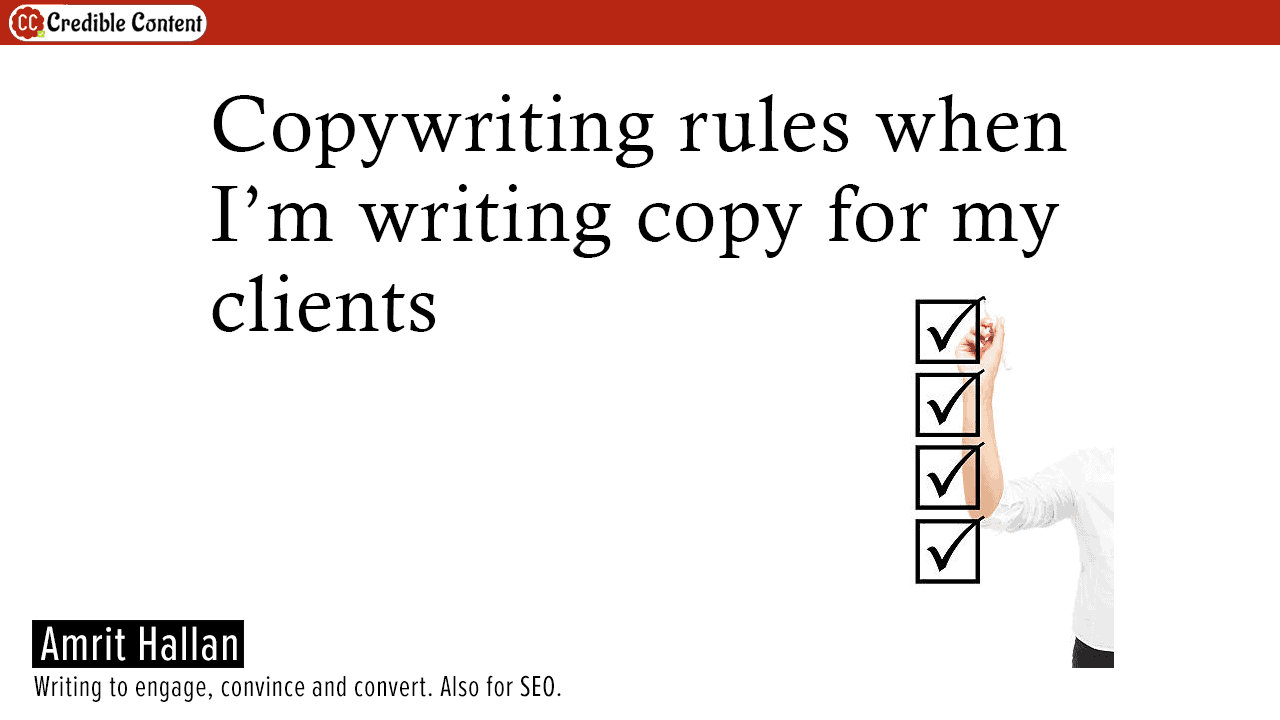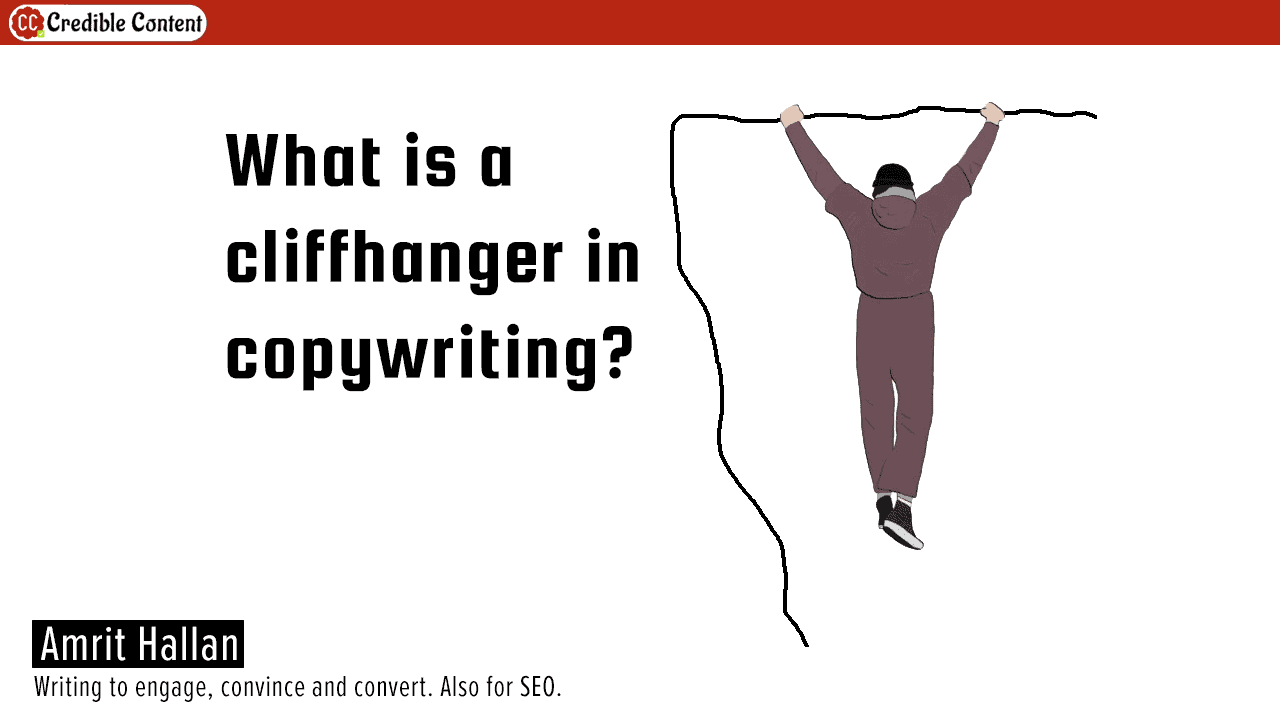
My copywriting rules when I’m writing copy for my clients.
The copywriting rules listed in this blog post help my clients generate more leads and get more business. What are these rules? Or what are these copywriting laws? Read on.
First, here is a quick list of the copywriting rules that I try to stick to as much as possible:
- Thoroughly understand the product or the service.
- Get a clear idea of whom you’re writing for.
- Use the language of the audience.
- Spend ample amount of time on the main headline.
- Avoid using big words and jargon.
- Use simpler sentences – mostly one thought in one sentence.
- Use call-to-action strategically.
- Create a sense of urgency (but don’t overdo it).
- Use positive language instead of negative.
- Focus more on benefits and less on features.
- Leverage storytelling.
- Stick to the point.
- Be your customer’s advocate.
Copywriting is a tricky undertaking. When I’m talking to my new clients, I always tell them that you cannot immediately get results from a landing page or an email marketing campaign.
You may not find these copywriting rules on other blogs not because they are unique, but because I implement them and hence, talk about them, in my own unique way.
Do I follow all these rules or laws? Not at all. In the end I will explain why. In fact, I used to believe that as long as you write well, there is no need to follow any particular copywriting laws.
Customer behavior is quite scientific these days. Ample amount of research is available that reveals to you what works and what doesn’t when you are writing copy. There are even certain words and expressions that, although mean the same, have different impact on your copy and through your copy, on your customers and clients.
4-5 landing pages or email marketing campaigns are needed before we can find out what works and what doesn’t.
No matter how experienced a copywriter is, experimentation is needed. A problem with freelance copywriters is that when a client approaches, she wants to know exactly how much a particular piece of writing is going to cost and how much is going to be delivered. Hence, there isn’t much scope to try out various rules or laws, especially when you want to evolve using your own copywriting techniques.
A copy is not about the number of words. It is about making an impact.
Due to this faulty, and yet inescapable approach, there is very little scope for experimentation, analytics, and learning.
Most of the clients move on after the first campaign. Some have access to analytics, and some don’t. They see that not much business was generated, and they think that may be there is something wrong in the copy.
I’m gradually shifting away from that model – quoting for the number of words – and instead, I focus on the result and quote accordingly, sometimes not even telling the client why I’m charging what I’m charging. Though, that’s a different topic.
Although results cannot be guaranteed with every campaign, there are some fundamental copywriting rules that can be followed when writing copy. Every audience is unique. Every set of customers and clients is unique. Nonetheless, certain steps that you take when writing copy always leave a positive impact.
Below I’m listing some rules that I follow when writing copy for my clients.
1. Understand the product or the service as clearly as possible
David Ogilvy in his book “Ogilvy on Advertising” says that before beginning to work on a copy, he did so much research that he would know more than the business owner. Of course, most of the clients don’t have that much budget, but whatever you can learn about the product or the service, try to learn it.
How can you write about something you don’t know of? Knowing about a product or service doesn’t just mean knowing what it does. It means how a product or a service helps customers and clients.
This is always my primary focus. What would draw people to this particular product or service? What overwhelming problem does the product or the service solve?
2. Define the target audience
In the content writing parlance, it is also called “defining the persona”.
Although I don’t psychoanalyze the audience such that it takes me hours to understand the people – obviously the client isn’t paying that much – I try to gather as much information as possible.
3. Adapt my writing to the language of the audience
What kind of language does the audience prefer? What language does the audience use when talking about similar products and services? You don’t want to alienate people by using a language that they don’t use.
Someone recently suggested that if you want to learn what type of language people use when talking about the product or the service that you are writing copy for (similar) visit other e-commerce websites and read the reviews and comments left by their users.
For example, if you’re describing the features of a mobile phone, visit a website like Amazon.com and go through various mobile phone listings, especially the reviews section.
4. Brainstorm on the main headline
I’m again going to quote David Ogilvy, “On the average, five times as many people read the headline as read the body copy. When you have written your headline, you have spent 80 cents out of your dollar.”
Some professional copywriters claim that out of the entire time, they spend 50% of the time on defining the headline. Sometimes they experiment with multiple headlines.
Although I won’t say that I spend 50% of my time coming up with the headline, I take my headline seriously. The headline must capture the essence of what is being written in the copy. The person who reads the headline should be immediately able to understand what the copy is about.
I make sure that the headline doesn’t confuse the reader. It must be straightforward. It must represent the biggest benefit or address the biggest problem.
But at the same time, I don’t believe in hyperbolic headlines. I try to create as realistic headlines as I can.
5. Avoid “big words”
By big words I mean, use “get” instead of “obtain” or “best” instead of “superior” or “help” instead of “facilitate”, and so on.
This also makes it easier to use conversational tone which makes your readers comfortable.
Of course, being a writer sometimes I get in the flow and use the words I shouldn’t be using but this normally happens in the first draft. By the time I’m through with revisions, I get rid of lengthier words if shorter versions are available.
6. Use simple sentences
This needs to be strategic. Too many simple sentences can sound like monosyllables or uninspiring. But, whenever I can, I express just one idea in one sentence and avoid using compound or complex sentences.
It makes it easier for the reader to read and understand what you are writing. In compound or complex sentences, one needs to process multiple thoughts at the same time, and this may end up confusing or distracting the reader.
7. Use call-to-action strategically
CTA or call-to-action is a big part of copywriting. The entire copy revolves around your CTA. The aim of your copy is to make the reader perform an action. This can be buying something, or replying, or downloading a brochure or giving a call, or registering for a workshop.
You can use call-to-action multiple times within the copy. It isn’t necessary that call to action must be used at the end. Whenever you express something compelling and you feel that the reader may be motivated to perform an action, you can insert a call-to-action.
But don’t overdo it; this makes you sound desperate.
8. Create a sense of urgency
I don’t believe in creating a sense of urgency just for the heck of it. I want to build trust among my readers. I create a sense of urgency when there is actual need.
For example, a client is organizing a workshop next week and he is making an offer to the first 25 attendees who register within the next two days.
In such cases, I use something like “This offer expires in two days and there is a mad scramble!”
9. Use positive prompts
It is something like instead of “Don’t spend your day in pain”, I write “Spend a painless day”. Another example would be, instead of “Don’t miss the opportunity”, I write “Grab the opportunity”.
10. Highlight benefits instead of features
I know, this is clichéd advice but even after coming across this advice for more than 273 times, I still see many copywriters getting obsessed with the features of a product or a service.
So, instead of giving more stress on the fact that your mobile phone has more than 300 GB of storage space, tell your prospective buyers that they can store 10,000 videos.
Instead of saying that your jeans is stretchable, you can tell your buyers that the same jeans can be worn by people of different sizes.
I’m not saying avoid features altogether. Features are important. I mean, 300 GB of storage space does sound appealing to a tech savvy person like me. Hence, don’t skip this part, but also don’t skip the part that the phone can save 10,000 videos.
11. Use storytelling
People relate to stories better. You have a great SaaS product with awesome features, but if you talk about some John who couldn’t afford expensive hardware and software and how he was able to grow his business using your SaaS product through a cheap, second-hand laptop, it can make a great impact.
12. Stick to the point
I don’t use fluff. I don’t beat around the bush. Of course, when you’re telling a story you need to build a narrative, but keep your audience focused. Even small distractions can make your readers lose track and go somewhere else.
13. Be the champion of the customer
I write copy as if I’m talking on behalf of my customers and clients. How are they going to benefit from the product or service I’m writing about? How is it going to change their lives?
Honestly, sometimes I feel insincere because how can I champion the cause of the customers for whom I’m writing, if I myself haven’t been using that product or service? I’m not an evangelist who has been using this product or service for years and have benefited immensely.
Take for example construction materials: these days I’m writing a series of marketing emails for a company that supplies construction materials and equipment to construction companies. I don’t have a construction company. I don’t use construction material. Still, I’m trying to convince those construction companies that they are going to get the best deal on the best materials from the company I’m writing about.
Well, this is something I need to reconcile with quite often.
Do I follow or implement all the copywriting rules I have mentioned above? Not necessarily. I pick and choose. Sometimes I use even random copywriting rules that I may have not listed above. I prefer to go with the flow. But these rules combine into a basic structure that keeps me on the right path. Even if you follow 50% of these rules, you are good to go.



